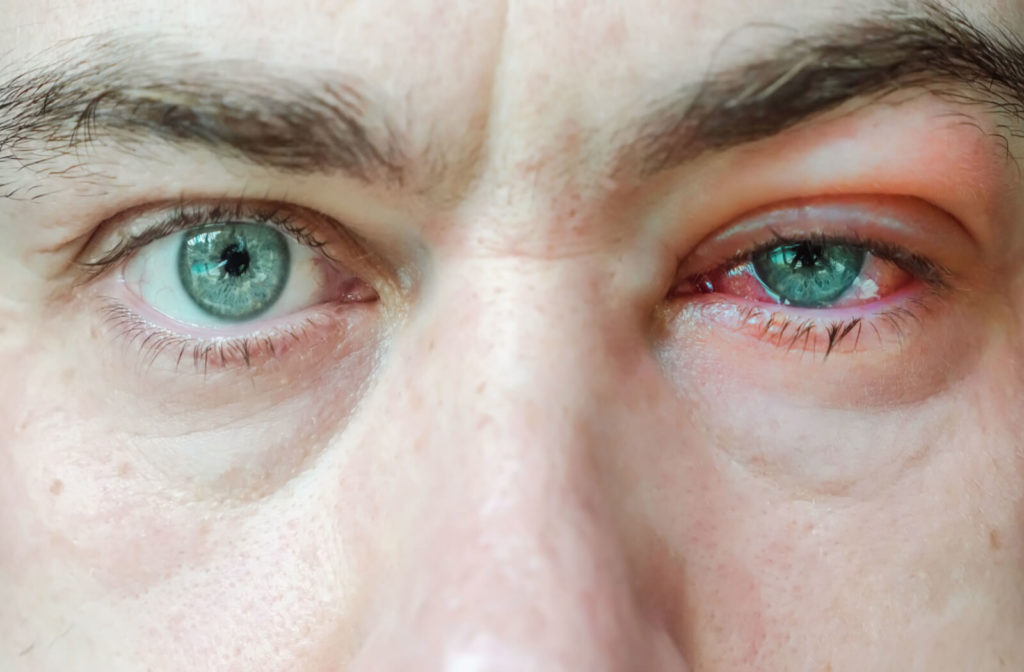Blepharitis is an uncomfortable condition that affects many Canadians. Fortunately, there are several home remedies you can try. If those don’t work, there are a few therapies your optometrist may be able to perform, which we’ll take a look at below.
Other than some occasional blurriness, blepharitis poses little risk to your vision by itself. However, it could possibly accompany other eye conditions. So, if you’re suddenly experiencing unusual symptoms, it’s always a good idea to get an eye examination to ensure that there are no underlying conditions to be concerned about.
What is Blepharitis?
Blepharitis is the inflammation and irritation of your eyelids. There is no single cause for the condition, and it’s very common. Most times, it can be treated with home remedies under the direction of your eye doctor.
Anterior blepharitis develops on the front exterior of your eyelid where the lashes emerge; the area becomes swollen and red. Whereas posterior blepharitis develops in the underside of your eyelid. Posterior blepharitis is considered the more common of the two. It is caused by your meibomian glands not functioning as they should.
Common symptoms of blepharitis include:
- Burning in the eyelid area
- Blurry vision
- Excessive tear production
- Flaking or crusty eyelids
- Light sensitivity
- Red and irritated eyes
- Red and swollen eyelids
Tips to Treat Blepharitis at Home
Although there is no permanent cure and blepharitis is often a chronic condition, it’s not difficult to manage. Even home remedies done at the direction of your optometrist are often very effective in helping clear the condition up.
Warm Compress
The symptoms of blepharitis are often more severe and uncomfortable when you first wake up. A warm compress 2 to 4 times per day is an excellent option for reducing the symptoms. Once the condition is under control, you can use the compress 1 or 2 times a day instead.
Putting a warm compress on for a few minutes at a time helps loosen any buildup. Then, a gentle massage on your eyelids can stimulate your meibomian glands to function properly.
Eyelid Cleansing
Part of using a warm compress should also include cleaning your eyelids once the buildup is loose. However, thorough cleaning alone is also a good home remedy if you have no way to do a compress.
Using a gentle soap like baby soap, gently scrub your eyelids. Then rinse them thoroughly with clean water and dry them. The best option is to perform this cleaning daily to help relieve the irritation caused by blepharitis and prevent more flare-ups.
Avoid Makeup or Contact Lenses
Going without contact lenses and not wearing makeup is not always the most convenient or easiest solution. However, suppose you’re struggling with chronic blepharitis. In that case, wearing contacts should be avoided, especially if you’re in the middle of a flare-up.
Diet Changes
Because blepharitis is often a chronic condition, it may be in your best interest to make some long-term diet changes. For example, including lots of healthy fats and omega-3-rich foods will help your overall eye health. These changes will also specifically help with meibomian gland function.
Blink More Often
This may seem like a strange solution. But quite often, as we age or perform close-up tasks, we don’t blink as much as we should. So, making a conscious effort to make sure you’re blinking enough is helpful. This ensures that your eyes stay lubricated, which helps with the irritation. The increased lubrication also helps prevent blepharitis from flaring up to begin with.

When Home Remedies Aren’t Enough
Home remedies are great because they often take the most natural approach to help and heal the body. But sometimes, a more aggressive treatment option is needed. Suppose your struggle with blepharitis doesn’t get better with home treatment. In that case, your eye doctor may recommend one of the following therapies.
Intense Pulsed Light (IPL) Therapy
IPL therapy is a great option for treatment if the root of your blepharitis is clogged meibomian glands. Intense light is pulsed in the area around your eyes. This causes the inflammation to go down and helps clear out any blockages in the glands. As this happens, it helps stimulate the glands to begin creating oil to lubricate your eyes.
Zocular Eyelid System Treatment (ZEST)
Warm compresses and daily cleansing with a soft soap only go so far. Sometimes, there is enough buildup that the little bit you get off doesn’t prevent more debris from contaminating your eye, and the cycle continues.
With ZEST, a special okra-infused product cleans your eyelids much more thoroughly than baby soap and a warm compress. A microsponge gently cleans away dead skin cells and other accumulations on the eyelid.
LipiFlow
LipiFlow is another in-office treatment that does a similar thing to home remedies. This treatment option uses targeted heat and a gentle massage to clean and stimulate the meibomian glands.
Find Out More About Treatment Options
If you’ve been suffering from the uncomfortable symptoms of blepharitis and these home remedies aren’t helping, give our office a shout. The friendly and knowledgeable staff at Zargar Eye Care are happy to answer all your questions. We’ll get you in for an appointment with one of our optometrists to examine your eyes and review your treatment options.

